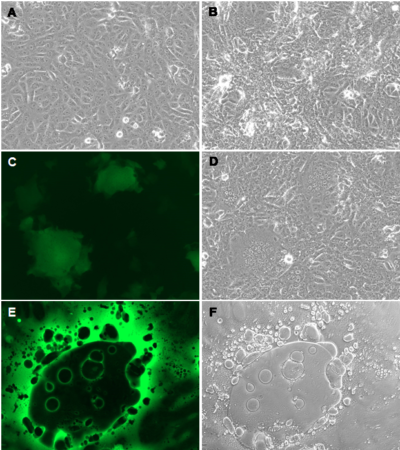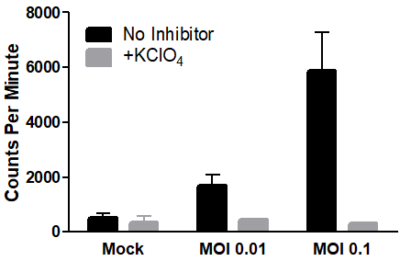Measles-GFP-NIS
| Strain | Edmonston vaccine lineage |
| Transgenes | Green fluorescent protein (GFP) Human sodium iodide symporter (hNIS) |
| Titer | >1e6 TCID50/mL (see description) |
| Risk Group | 2 |
-
Description
Measles-eGFP-hNIS is a recombinant of the live attenuated Edmonston strain of measles virus. The enhanced green fluorescent protein (eGFP) and human sodium iodide symporter (hNIS) cDNAs are inserted as additional transcription units upstream of the nucleocapsid (N) gene and downstream of the hemagglutinin (H) gene, respectively (see diagram below). The purchased virus is ready to generate additional virus stocks.

The virus titer is functional infectious virus, not total virus particles, in clarified supernatant. The titer is determined using an end-point dilution assay that measures the amount of virus required to produce cytopathic effects in 50% of infected cells (tissue culture infective dose per mL).
-
Propagation
Basic protocol
(All volumes are given for a T75 flask; increase or decrease as needed.)
1. Seed producer cells (e.g. Vero) in complete medium at an appropriate density to achieve 80-90% confluency at the time of infection and incubate in an appropriate incubator.
2. Thaw the virus stock on ice.
3. In a microcentrifuge tube, prepare virus at a MOI of 0.02 in 3 mL total serum free media.
4. Remove culture medium from cells and replace with prepared virus. Return cells to incubator.
5. After 2-3 hours, remove virus innoculum and replace with 12 mL complete medium. Return cells to incubator.
6. Harvest supernatant when 80-90% of cell monolayer has formed syncytia; usually 2-3 days post-infection.
7. Perform 2 freeze-thaw cycles. Aliquot virus supernatant and store at -80C. Determine virus titer using an appropriate method. -
Transgene Validation
Infectivity

A & B: Mock-infected cells at 24 (A) and 48 (B) h.p.i.
C-F: Measles-eGFP-hNIS-infected Vero cells (MOI 0.1) at 24 (C & D) and 48 (E & F) h.p.i.
NIS Expression

Vero cells were mock-infected or infected with Measles-eGFP-hNIS at the indicated MOIs. After 48 hours, uptake of I-125 was measured in the presence or absence of KClO4, an inhibitor of NIS-mediated I-125 uptake.
- Datasheet/COA